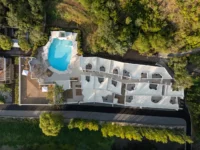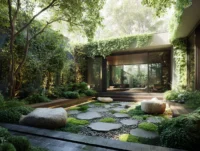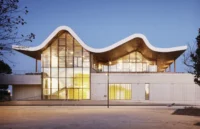Fenix Art Museum, located on a prominent site in Rotterdam’s historic City Harbor, explores migration through the lens of art, architecture, photography, food, and history. Housed in a monumental 16,000-square-meter former transshipment warehouse, the museum occupies a peninsula overlooking the docks where millions of migrant journeys began and ended. The project is MAD Architects’ first European public cultural commission and the first museum in Europe designed by a Chinese firm. Initiated by the Droom en Daad Foundation, Fenix reflects Rotterdam’s diversity, history, and creative potential, transforming a once-industrial site into a dynamic cultural destination.

Restoration and Façade Intervention
The restoration of the 172-meter-long warehouse façade was a key intervention, completed in 2019 with consultation from Bureau Polderman. Elements from the 1923 warehouse and the 1948–1950 reconstruction were carefully conserved, while later alterations were removed. Characteristic windows were restored, sliding doors repainted green to match the post-war palette, and cement stucco reapplied along the south façade. The intervention reinstated a serene rhythm of columns, windows, and portals, emphasizing the horizontal quality of the warehouse. These measures honor the building’s history while providing a cohesive, visually striking façade befitting a contemporary museum.

Spatial Experience and the Tornado
A defining feature of Fenix is the Tornado, a double-helix staircase that spirals from the ground floor to a rooftop platform, offering panoramic views of Rotterdam and the Maas River 24 meters above ground. Clad in 297 polished stainless-steel panels and topped with a 17-meter canopy, the structure is both a visual centerpiece and an experiential landmark. Inside, the staircase is made from sustainable Norwegian Kebony wood, forming a 550-meter-long double-helix that winds through the atrium. The Tornado integrates natural light through a glass roof, creating a dynamic interplay of shadow and illumination, guiding visitors through the museum and establishing a strong spatial identity.

Galleries and Programmatic Layout
The museum’s interior comprises expansive gallery spaces over two floors. The ground floor accommodates exhibition areas, programming spaces, and Plein—a flexible 2,275-square-meter area for events, performances, and community engagement. Plein is designed to open onto three sides, extending the public space and creating a welcoming environment for Rotterdam’s residents. Upstairs galleries house the Fenix Collection, featuring historic and contemporary art alongside site-specific commissions by emerging international artists. Central atrium spaces connect the floors, while entrances on the north and south façades allow easy access and encourage visitor circulation. Dining options distributed throughout the building further enhance the cultural experience by reflecting global food traditions.

Sustainability and Environmental Design
Fenix demonstrates a strong commitment to environmental responsibility. The rooftop features a 6,750-square-meter green roof, supporting biodiversity, insulating the building, and managing rainwater. The museum employs a Thermal Energy System (TES) coupled with a heat pump that uses the aquifer as a source, achieving up to 60% savings in heating and 80% in cooling energy. Passive cooling, underfloor heating, and the use of sustainable materials—including Kebony wood for the Tornado staircase—reinforce the building’s environmental performance. By restoring the historic warehouse while integrating modern systems, Fenix exemplifies the synergy of heritage preservation and sustainable architecture.

Accessibility and Community Engagement
Fenix was designed in consultation with VGR to ensure accessibility and inclusivity. The atrium and Plein provide publicly accessible spaces free to enter, fostering community interaction and cultural exchange. The museum’s design balances large-scale exhibition functions with intimate encounters, offering a welcoming environment for both visitors and local residents. By merging historic restoration, innovative architecture, and sustainable practices, Fenix Art Museum emerges as a landmark institution that honors Rotterdam’s maritime heritage while looking toward a future defined by creativity, cultural dialogue, and environmental responsibility.
Photography: Titia Hahne & Iris van den Broek & Rotterdam City Archives
- Adaptive reuse design
- Art and migration theme
- Atrium spatial experience
- Bioclimatic museum design
- community engagement architecture
- Contemporary museum architecture
- Fenix Art Museum
- Flexible exhibition spaces
- Green roof integration
- heritage and modern architecture
- Historic façade restoration
- MAD Architects
- Maritime heritage Rotterdam
- Museum design Europe
- Public cultural space
- Rotterdam cultural architecture
- Scandinavian wood materials
- Sustainable Architecture
- Tornado staircase
- Warehouse conversion










































Leave a comment